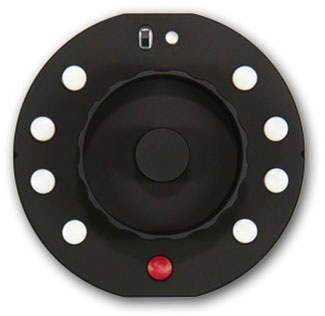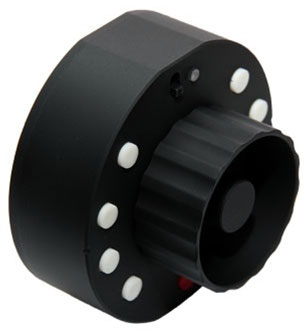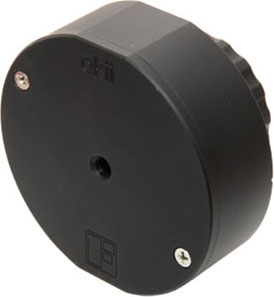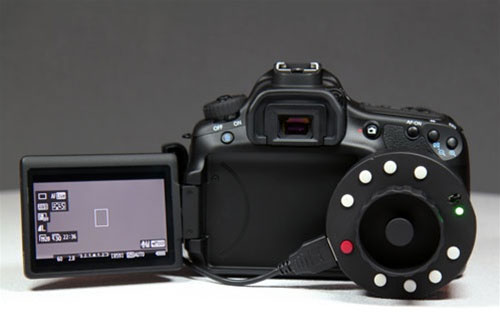The Okii FF-001 USB Follow Focus controller is said to work with the Canon EOS-1D Mark IV, 5D Mark II, 7D, 60D, Rebel T2i (aka 550D / Kiss X4), and Rebel T1i (aka 500D / Kiss X3). Inside an anodized, milled aluminum enclosure, the FF-001 includes everything needed to communicate via USB with the cameras, and not only to remotely control focus, but also to start and stop video recording, toggle Live View, capture a still image, automatically adjust focus or exposure, and control the main exposure variables -- aperture, shutter speed, ISO sensitivity, and exposure compensation. While the USB Follow Focus device is connected, you can continue to use either the rear-panel LCD or an attached high-definition HDMI display to view the camera's user interface or Live View feed, and the FF-001 can also control the focus assist zoom, allowing more precise focusing with either 5x or 10x magnification.
A chunky dial and a selection of nine buttons around the top face of the FF-001 are used to control the camera, as well as the device itself. The buttons themselves are replaceable, and Okii offers in white, black, green, blue, and red colors, allowing the button color for each function to be customized to the user's preference. By default, the device comes assembled with eight white buttons and one red one inserted, while one extra button in each color is provided in the product bundle, along with a 36-inch USB cable. As well as controlling focus manually via the follow focus dial, you can also predefine four focus distances, and then program the FF-001 to automatically jump between these predefined focus points as commanded.

|
Front face of the Okii FF-001 USB Follow Focus controller.
Photo provided by Okii Systems LLC. |
There's a choice of three focus step sizes available from the Okii Follow Focus device, as dictated by Canon's underlying protocol, and these provide either more accurate but slower focus adjustment, or faster but coarser-grained adjustment, with their individual usability varying from lens to lens. Of course, since the focusing operation is performed using the lens' focus drive motor, the usual provisos about motor noise apply. For those with programming experience, the USB Follow Focus device is both open source, and compatible with Arduino's cross-platform Java integrated development environment, allowing users to fine-tune its operation or create their own functionality. The Okii FF-001 draws its power from two AAA batteries said to provide for 30+ hours of use, weighs 4.7 ounces loaded and ready to shoot, and is designed to fit comfortably in the palm of the hand. A standard 1/4"-20 tripod socket on the unit's base allows it to be mounted, if preferred.

|
Three quarter view of the Okii USB Follow Focus controller.
Photo provided by Okii Systems LLC. |
Note that some important provisos as to the Okii USB Follow Focus controller's use are detailed in a support document on the company's website. These relate to limitations of the protocol used by Canon's cameras, which wasn't necessarily designed with this usage in mind. Most significantly, Canon's protocol doesn't provide any mechanism with which to confirm a focus adjustment was performed, and so if the camera is busy upon receipt of a focusing command, it is possible that no adjustment will be made when the follow focus knob is rotated a short distance. This can lead to one of the main differences from a traditional mechanical follow focus device, in that when you rotate the knob and then return it to its original position, it's possible that the point of focus won't be the same as that at which the camera began.

|
Rear quarter view of the Okii USB Follow Focus controller.
Photo provided by Okii Systems LLC. |
Another significant difference from a mechanical device is that Canon's protocol only allows a certain number of operations per second, beyond which point focus commands may be ignored. If they're flooding the camera fast enough, it's even possible to lock the camera up altogether. The speed at which commands can be received depends on the specifics of the lens attached, and for this reason, the FF-001 includes the ability to adjust the rate at which focus commands are sent. Both of these points can of course cause issues for the FF-001 when switching between its four predefined focus distances, with problems becoming more likely the faster focusing commands are sent. In addition, some lenses don't have the same step size when adjusting focus towards or away from infinity focus, which can make it difficult to use the device's automatic functionality, necessitating either recalibration before filming begins, or manual control of focus operation using the follow focus knob. It's for this reason that Okii ships the FF-001 with a 30-day return policy, allowing videographers to test it with their gear, and be certain of its compatibility.
The Okii FF-001 is available immediately, priced at US$400. More information can be found on the Okii website, and on the 5D Mark II Team website. Three short clips demonstrating the device's performance can be seen on the Vimeo video sharing site.

|
The Okii USB Follow Focus controller alongside a Canon DSLR for scale.
Photo provided by Okii Systems LLC. |